
Prostanthera - Australian Mint Bush: Planting and Growing
Contents
The Prostanthera in a nutshell
- Prostanthera are small Australian bushes with white, pink, or purple flowering
- Slightly frost-sensitive, Australian mints are best suited to regions with a mild climate
- The evergreen foliage is highly aromatic and releases a scent of mint or camphor
- Prostanthera are grown in partial shade to full sun
- The bush adapts to sandy or clay soil, acidic to neutral, but must remain moist and well-drained
The word from our expert
A bushy mint? What a funny idea! And yet, that’s exactly what Prostanthera, also known as Mint Bush or Australian Mint, is called. It’s not actually a mint, but the two plants share the same botanical family, Lamiaceae, as well as a pronounced fragrance when the leaves are crushed. In the case of Prostanthera, this scent resembles mint or sometimes camphor. This foliage is also evergreen.
Flowering occurs in spring and sometimes extends into summer for the Prostanthera cuneata (the hardiest of the bunch!). The multitude of flowers, shaped like a galea, are typically white, pink, purple, or mauve, depending on the species.
Given its southern origins, you’ll easily understand that this bush isn’t the hardiest. Therefore, Prostanthera is best grown in the ground, preferably in the southern part and along the west coast of the country. However, it can also be grown in pots and moved to a frost-free location in winter. Prostanthera isn’t fussy about soil: it thrives in sandy or clay soils, acidic to neutral, but must remain moist and well-drained. As for exposure: full sun in the north, but partial shade in the hottest regions of the country.
Botany and description
Botanical data
- Latin name Prostanthera sp.
- Family Lamiaceae
- Common name Australian mint, Bush mint
- Flowering April to August
- Height up to 2 m
- Exposure sun or partial shade
- Soil type all types but fresh and well-drained
- Hardiness -6°C to -3°C
The genus Prostanthera comprises 90 species, all native to eastern or southeastern Australia (particularly New South Wales). Australian mints or bush mints belong to the Lamiaceae family, well-known to gardeners, especially for the most cultivated aromatic plants: mint, sage, thyme, rosemary… In Australia, Prostanthera are commonly called “Mint bush.” The genus name Prostanthera comes from the Greek “Prosteke,” meaning “appendix,” and refers to the protuberances on the anthers where pollen forms.
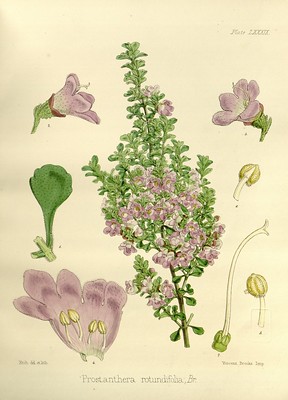
Prostanthera rotundifolia (botanical plate circa 1840)
The most common species are Prostanthera cuneata, Prostanthera ovalifolia, Prostanthera rotundifolia, but you can also find Prostanthera caerulea, Prostanthera lanceolata, Prostanthera nivea var. induta, Prostanthera lasianthos, Prostanthera melissifolia, Prostanthera staurophylla (Tenterfield Mint Bush), and Prostanthera sieberi.

Prostanthera rotundifolia, Prostanthera cuneata (© color line) and Prostanthera lasianthos (© Leonora Enking)
Typically, Prostanthera are small bushes, usually very branched : less than a metre high for Prostanthera cuneata. But some form beautiful shrubs up to 2 m tall, like Prostanthera ovalifolia or Prostanthera caerulea. Others still form small trees nearly 10 m tall in their natural habitat, such as Prostanthera lasianthos. In short, the genus Prostanthera is vast and diverse.
The foliage is evergreen and releases a strong camphor or mint scent when crushed. This fragrance has earned it the nicknames “Bush mint” or “Australian mint.” The leaves are single and opposite and grow abundantly along the stems. Note that the branches and stems often have a square cross-section, a characteristic of the Lamiaceae family.
Flowering occurs in spring or summer, depending on the species, and is usually arranged in clusters. Each flower is more or less bell-shaped, but the two typical lips of the Lamiaceae family are clearly distinguishable. The upper lip forms a helmet with two fused lobes, while the lower lip, marked at its base by a yellow spot, has three well-defined lobes. Depending on the species, the flowers can be white, yellow, green, blue, purple, mauve, or even red.

Prostanthera incisa (© HQ), Prostanthera junonis and Prostanthera rose
The flowers are very nectariferous and attract a multitude of pollinating insects (bees, bumblebees, butterflies…), even in our latitudes.
The fruiting that follows flowering produces very small nutlets: a nutlet is a fruit with a very hard wall, like a hazelnut, for example.
Read also
Mint: planting, growing, propagatingOur most beautiful varieties
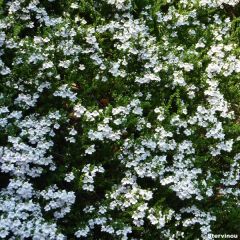
Prostanthera cuneata - Mint Bush
- Flowering time June to September
- Height at maturity 60 cm
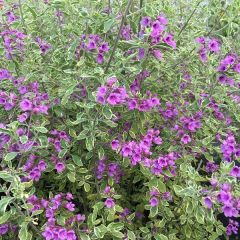
Prostanthera ovalifolia Variegata - Mint Bush
- Flowering time May to July
- Height at maturity 2,10 m
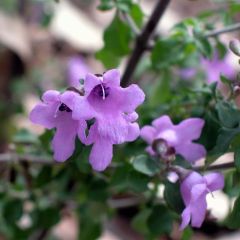
Prostanthera rotundifolia - Mint Bush
- Flowering time May, June
- Height at maturity 2 m

Prostanthera rotundifolia Variegata
- Flowering time May, June
- Height at maturity 1,50 m
Discover other Prostanthera
View all →Available in 1 sizes
Available in 2 sizes
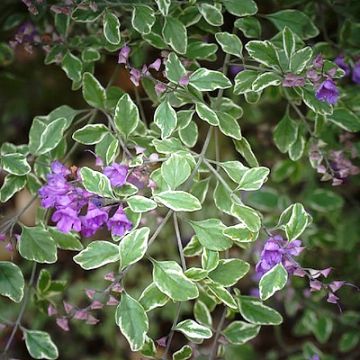
Available in 1 sizes
Available in 1 sizes
Available in 1 sizes
Planting Prostanthera
Where to Plant?
Prostanthera adapts to a wide range of soils: clay soils, sandy soils, stony soils, even granitic soils. The soil pH should be neutral to acidic, ideally around pH 6. Australian mints dislike calcareous soils.
The soil should remain moist but well-drained. A heavy, waterlogged soil in winter will significantly reduce the hardiness of the bush. However, Prostanthera rotundifolia tolerates drought well.
Prostanthera are relatively frost-sensitive, hardy only to -6°C for most varieties. They should therefore be planted in the ground preferably in the southern and south-western parts of France or grown in pots to be sheltered from frost during winter. However, Prostanthera cuneata can withstand snow and temperatures as low as -12°C. This species can be planted in the ground even in northern regions, provided the soil is well-drained.
Note that Prostanthera tolerates sea spray relatively well but dislikes cold winds. As for exposure, Prostanthera enjoys full sun or partial shade in the South, but Prostanthera cuneata tolerates shade well.

Prostanthera cineolifera in its natural habitat (© Ruth P)
When to Plant?
Planting is done in autumn (September-October) or spring (March to May), avoiding frost periods. If winters are cold (frosts down to -9°C) and wet in your area, it is better to plant in spring, between April and May.
How to Plant?
In the Ground
- Once you have chosen the location, dig a planting hole, two to three times the size of the root ball;
- Feel free to mix coarse sand or gravel into the soil to improve drainage. You can also mix some heather soil with the excavated soil to help lighten and acidify the soil;
- Remove the bush from its pot and place it in the centre of the planting hole, ensuring the collar is level with the soil surface;
- Fill the hole with the excavated soil and lightly firm it down with your fingers;
- Water thoroughly to moisten the soil and eliminate any potential air pockets between the soil and the roots.
In a Pot
- Choose a pot with a minimum volume of 6 to 10 litres and equipped with drainage holes at the bottom;
- For the substrate, a mix of 1/3 heather soil and 2/3 good-quality universal compost will be perfect;
- Place a layer of gravel or clay pebbles at the bottom of the pot to fill without blocking the drainage holes and prevent the substrate from escaping. Add a first layer of compost at the bottom of the hole;
- Remove the plant from its pot and place it in the centre of the pot. Fill the remaining space with the compost and heather soil mix. Lightly firm it down with your fingers;
- Water thoroughly.
Maintenance and pruning
Maintenance will involve regularly watering the plant at its base during dry periods. Avoid wetting the foliage exposed to sunlight.
In regions with harsh winters, bring the bush indoors if it’s potted or, if planted in the ground, apply a good mulch at its base (dead leaves, herbs…) to protect the stump, or even use winter fleece. This mulch will also help keep the soil slightly moist in summer.
Remove faded flowers daily!
Pruning should be done in March or just after flowering. Pruning is not really necessary, but you can trim the branches slightly to maintain a compact shape, especially in pots. You can also regularly remove diseased or dead wood.

Prostanthera linearis
Diseases and pests
Prostanthera plants rarely suffer from diseases. However, in damp and poorly drained soil, the roots may rot due to an attack by a fungus of the genus Phytophtora. New selections of Prostanthera cuneata are more resistant to this disease.
If you grow your Australian mint in a greenhouse or conservatory, whiteflies (commonly known as “whiteflies”) and red spider mites (which are actually mites) may infest the plant. Daily misting will help prevent this.
→ The advice sheet Whiteflies: identification and treatment and the advice sheet Red spider mites: identification and treatment may be useful in case of infestation.
Multiplication
By sowing
Sow the seeds in April, in pots or trays, in a special sowing substrate. Keep the compost moist but not waterlogged during germination and the growth of the young seedling. Transplant the seedlings in autumn into individual pots and plant them in the ground the following spring.
By cutting
Cuttings should be taken in July-August. Take semi-hardened terminal shoots about 15 cm long. Plant them in pots in a light substrate, such as a special sowing and cutting compost. Keep the compost moist but not waterlogged. Place your cuttings in partial shade. You can plant them in the ground the following spring.
How to pair Australian mint?
Prostanthera should be paired with plants that require the same growing conditions: warmth, well-drained soil that remains moist.
A Prostanthera rotundifolia ‘Variegata’ will thrive alongside a bush from the coastal heathlands of Australia: the Melaleuca squamea, a small evergreen bush with flowering clusters resembling tiny brushes. Also native to southeastern Australia (and New Zealand), Leptospermum are stunning small bushes with aromatic evergreen foliage: Leptospermum scoparium ‘Martini’ blooms with single flowers, transitioning from pale pink to deep pink between April and June. The Grevillea juniperina, also known as the juniper-leaf grevillea, is a beautiful evergreen bush of Australian origin, capable of flowering throughout winter into spring in mild climates, with clusters of bright red flowers.

A New Zealand-inspired pairing featuring a Prostanthera rotundifolia ‘Variegata’, a Leptospermum scoparium ‘Martini’, a Melaleuca squamea (© JJ Harrison), and a Grevillea juniperina
Of course, no one is obliged to pair a Prostanthera exclusively with plants of Australian origin. Mediterranean bushes (oleanders), plants from the desert regions of America (Leucophyllum frutescens), or even some African varieties (Gomphostigma) can also serve as excellent companions in the garden.
Also worth reading
→ Discover all our Prostanthera in our online nursery.
- Subscribe!
- Contents



































Comments